Reports
Most Nuclear Ban Treaty Proponents are Lagging in Implementing Sound Export Control Legislation
by David Albright, Sarah Burkhard, Allison Lach, and Andrea Stricker
September 27, 2017
Using data compiled from a new index by our Institute, the Peddling Peril Index, which we will soon release, three quarters of the countries that voted in July 2017 in favor of the Treaty on the Prohibition of Nuclear Weapons lack adequate export control legislation. These countries lack a firm basis to control the export or retransfer of nuclear and nuclear-related commodities that are critical to the production and possession of nuclear weapons. If the UN Ban Treaty proponent countries truly seek a world without nuclear weapons, they should take the lead in ensuring that all countries, including their own, have effective strategic trade control systems able to prevent the spread of dangerous commodities and facilities that are critical to the production, maintenance, and improvement of nuclear weapons.
On July 7, 2017, a United Nations conference charged with negotiating a treaty prohibiting nuclear weapons voted in Geneva to accept a sparse, ten-page document with grand ambitions to ban nuclear weapons worldwide.1 This treaty opened for signature to all states on September 20, 2017. At the conclusion of the negotiations in July, 122 countries in the conference voted in favor of accepting the treaty as negotiated. Not a single country currently possessing nuclear weapons voted that day to support the Ban Treaty. Furthermore, the Netherlands was the only NATO member involved in the negotiations, and it voted against the treaty at the conference in Geneva.2
The preamble of the Ban Treaty contains a statement that, while on the surface, seems innocuous, is actually a setback for efforts to stop or slow nuclear weapons proliferation through the implementation of strategic trade control laws and regulations. The preambular language, “Emphasiz[es] that nothing in this Treaty shall be interpreted as affecting the inalienable right of its States Parties to develop research, production and use of nuclear energy for peaceful purposes without discrimination.”3, 4 This phrase has historically been at the heart of the argument used by countries, such as Iran, which have sought nuclear weapons capabilities via uranium enrichment or reprocessing, that there exists a global right to free nuclear trade which inherently counters export controls. By implication, therefore, for many of these countries, regimes controlling nuclear supply should not exist or should not apply to them. Their position is counter to that of many countries that seek to stop the spread of dangerous nuclear and nuclear-related commodities. For many of them, stopping the unauthorized export or transshipment of goods or facilities associated with nuclear reactors, plutonium reprocessing, uranium enrichment, and nuclear weaponization is a critical function of trade controls, because they see this proliferation as unduly increasing the risk that more countries will acquire nuclear weapons. The widespread lack of adequate export controls would also make the verification of nuclear disarmament extremely difficult, if not impossible, as the global economy expands. Significantly, the Ban Treaty is silent on exactly how nuclear disarmament would be verified and the challenges posed by the spread of civilian reprocessing and enrichment capabilities to any effort to prevent or reverse nuclear armament.
Because of this problematic preambular language, we decided to test a new tool the Institute has developed and will soon release publicly, the Peddling Peril Index (PPI), which measures the extent and effectiveness of a country’s strategic export control systems, particularly as related to controlling nuclear and nuclear-related goods. We wanted to characterize the countries that voted for the document in July 2017 in Geneva as to their commitment to export controls. The Index found that the majority of countries (about 76 percent, or 93 out of 122) that voted in favor of the Ban Treaty in July do not have adequate export control legislation. This lack is a sign that these countries lack a firm basis to control the export or retransfer of strategic goods through their countries.
We noticed that several of the countries that voted in favor of the treaty are also those that have fought against strengthening the nuclear non-proliferation aspects of the Nuclear Non-Proliferation Treaty (NPT) at the NPT Review Conferences, and against strongly implementing UN Resolution 1540, which mandates all UN member states to implement national export control systems to counter the spread of weapons of mass destruction. It is also noteworthy that a vast number of the initial signatories of the Ban Treaty (97 out of 122) are members of the Non-Aligned Movement (NAM).
Findings
As part of the research for the PPI, the Institute analyzed specific export control legislation of 200 nations or territories. Our findings placed countries and territories into five categories regarding the quality and extensiveness of a country’s export control legislation relating to nuclear and nuclear-related dual use goods. Ideally, national export control legislation takes into consideration a comprehensive list of controlled items, such as Nuclear Suppliers Group (NSG) Parts I and II lists.
In this test of the PPI, countries that voted for the Ban Treaty in Geneva were categorized into the five levels of comprehensiveness of their control lists established by the PPI. The categories are Red, Orange, Yellow, Light Green, and Dark Green, with Red being the worst and Dark Green being the best.
The findings include:
Red : 40 of the countries that voted in favor of the Ban Treaty in July 2017 in Geneva. Their export controls may include small arms and light weapons (SALW), and/or radioactive materials under environmental laws. These are not considered relevant export control legislation for the PPI.Orange : 34 of the countries that voted in favor of the Ban Treaty. Export control legislation or agreements include only conventional weapons as laid out under the Arms Trade Treaty. These are not considered relevant export control legislation for the PPI.Yellow : 19 of the countries that voted in favor of the Ban Treaty. These countries have comprehensive, overarching nuclear safety and security laws which place transfer controls on nuclear material and equipment. If we were unable to locate the relevant legislation, the 2016 Nuclear Threat Initiative (NTI) Nuclear Security Index was consulted, specifically its data on whether a country has or does not have a national legal framework for the Convention on the Physical Protection of Nuclear Material (CPPNM). These countries are not viewed as having effective export control laws governing nuclear and nuclear-related commodities, but their existing legislation is viewed as better in a relevant export control sense than the legislation or lack of legislation in the red and orange categories.Light Green : 5 of the countries that voted in favor of the Ban Treaty. Export control legislation or agreements includes controls or clauses relating to nuclear direct-use goods (i.e. nuclear commodity controls such as implementation of Nuclear Suppliers Group Part I list or an equivalent), and conventional weapons.Dark Green : 24 countries that voted in favor of the Ban Treaty. Export control legislation or agreements includes controls or clauses relating to nuclear direct-use and nuclear dual-use goods, (i.e. nuclear and nuclear-dual use commodity controls such as implementation of NSG Parts I & II or their equivalent).
Upon comparing the legislation of the 122 countries that voted in favor of the UN Ban Treaty in July and those that did not, only 24 percent (or 29 countries) of intended signatories have adequate export control legislation, compared to 76 percent (or 93 countries) of those that did not vote in favor (see Figures 1 and 2).
As noted above, the majority of countries that did vote for the Ban Treaty are also members of the NAM. Of the 97 countries that are both NAM members and voted for the treaty, only 14 have adequate export control legislation. Of the 55 countries that are not in the NAM and did not vote for the treaty, 49 have adequate export control legislation (see Figure 3).
These results follow a general trend. Of the countries that belong to NAM, only 17 percent have adequate export control legislation compared to 80 percent of the 80 countries that do not belong to the NAM (see Figures 4 and 5).
Conclusion
The Ban Treaty appears to be supported mostly by countries that show little commitment to strategic export controls, a fundamental international tool to stop the spread of nuclear weapons and slow the growth of nuclear arsenals. The preamble language of the treaty may further open the door to those states that seek to undermine export controls, an action inconsistent with the goal of achieving a world without nuclear weapons and stopping the spread of nuclear weapons to other countries. If the UN Ban Treaty proponent countries, in particular NAM countries, truly seek a world without nuclear weapons, they should take the lead in ensuring that all countries, including their own, have effective, implemented national export control legislation capable of preventing the spread of dangerous commodities and facilities that are needed to make, maintain, and improve nuclear weapons.
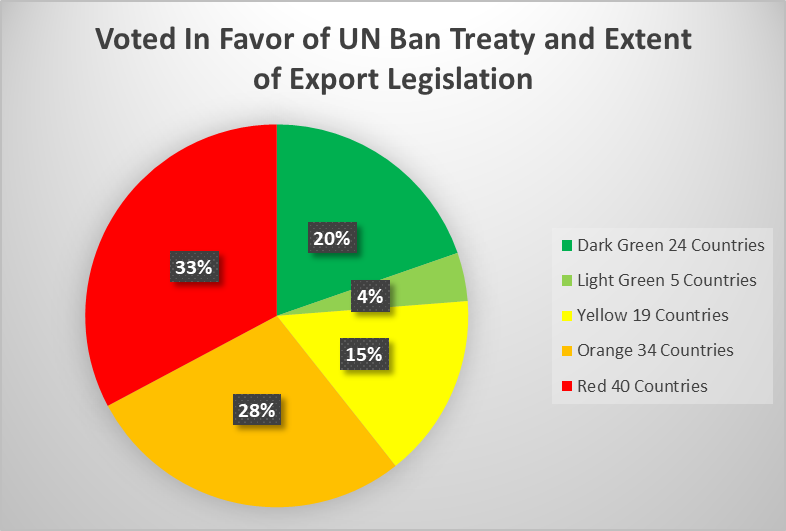
Figure 1
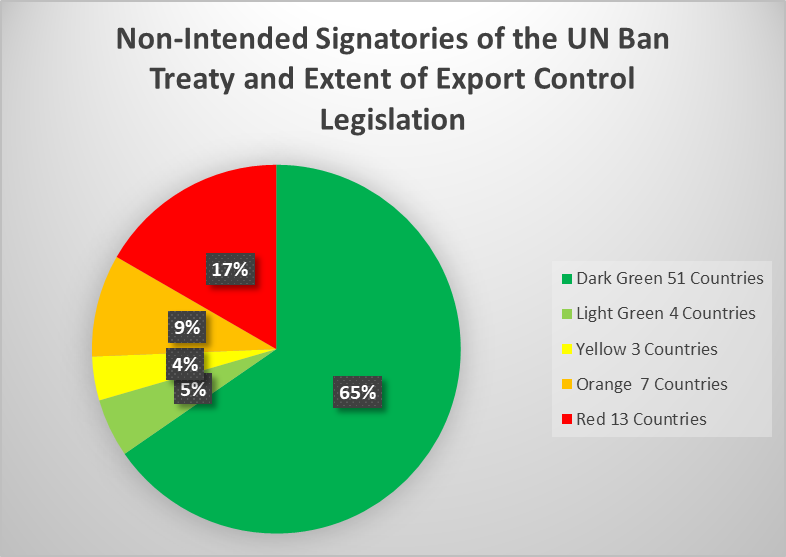
Figure 2
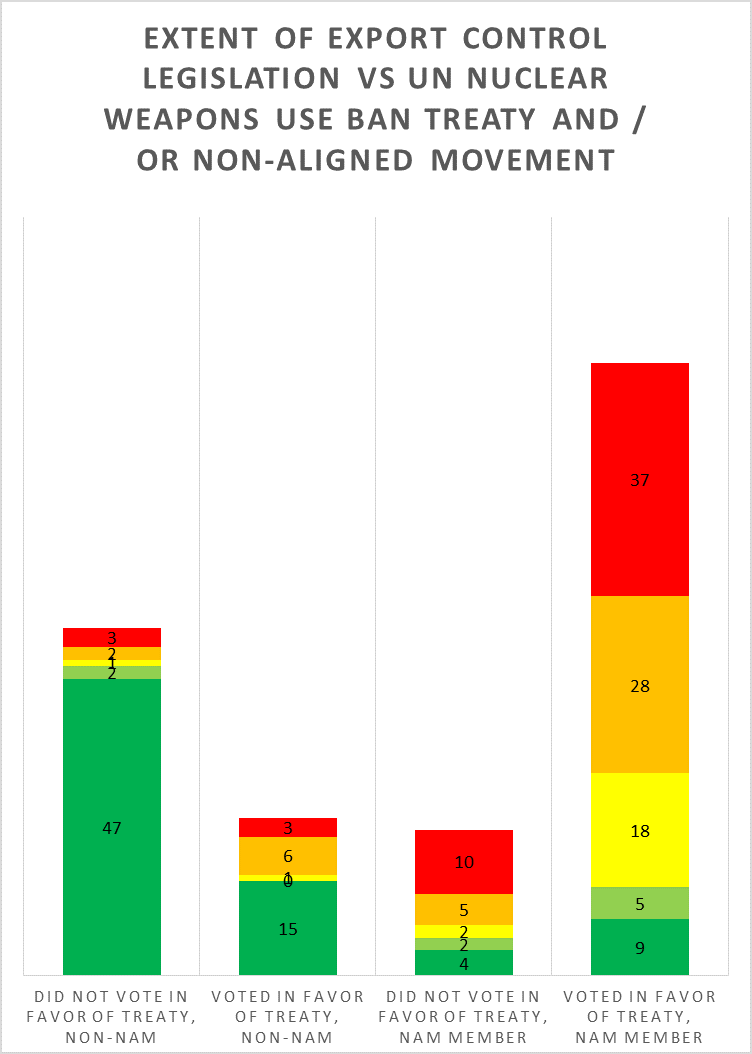
Figure 3. In the second column from left, the number 1 signifies one country in the yellow category. The number 0, which slightly overlaps, signifies no country is in the light green category.
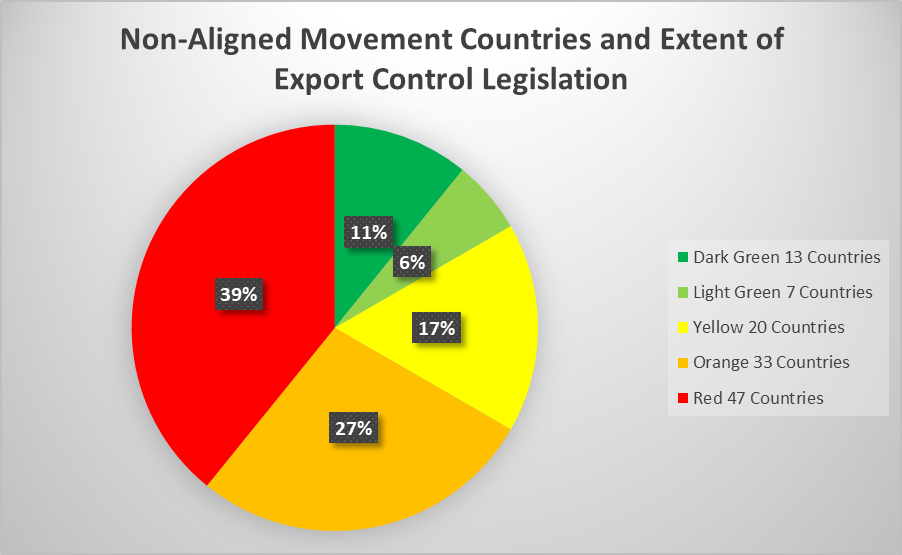
Figure 4
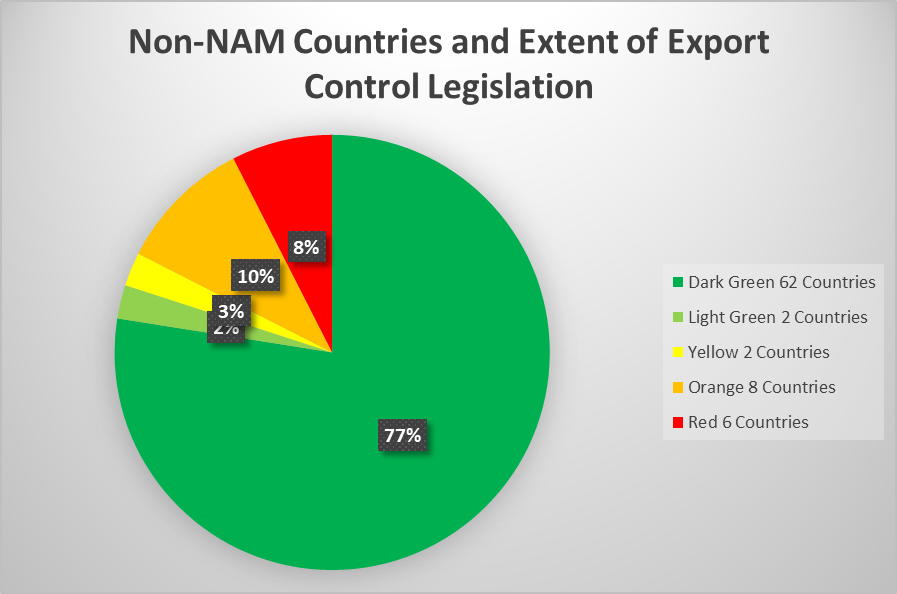
Figure 5
1. UN News Centre, “UN Member States Set to Adopt ‘Historic Treaty Prohibiting Nuclear Weapons,” July 6, 2017, http://www.un.org/apps/news/story.asp?NewsID=57131#.WbqeG8iGMdV ↩
2. Peter D. Zimmerman, “This New U.N. Treaty Seeks to Ban Nuclear Weapons. But We’d Regret it if We Did,” The Washington Post, September 14, 2017,https://www.washingtonpost.com/news/posteverything/wp/2017/09/14/the-u-n-s-new-treaty-banning-nuclear-weapons-sounds-like-a-good-idea-its-not/?utm_term=.c05ca8111cf4 ↩
3. United Nations General Assembly, Draft Treaty on the Prohibition of Nuclear Weapons, July 6, 2017,http://undocs.org/A/CONF.229/2017/L.3/Rev.1 ↩
4. This phrase undercuts the Nuclear Non-Proliferation Treaty, where this exact phrase is conditioned by its being exercised in conformity with Articles I and II (and some would say, necessarily, with Article III, as well). ↩

 twitter
twitter